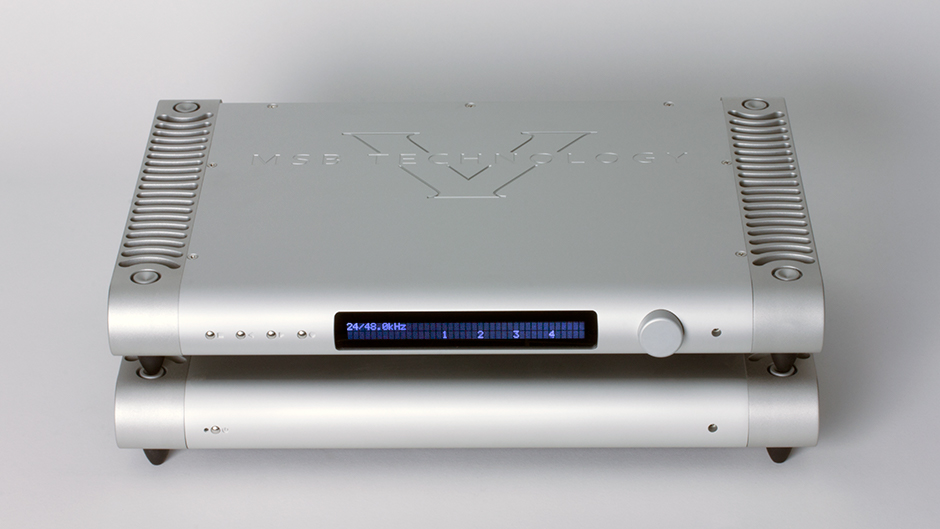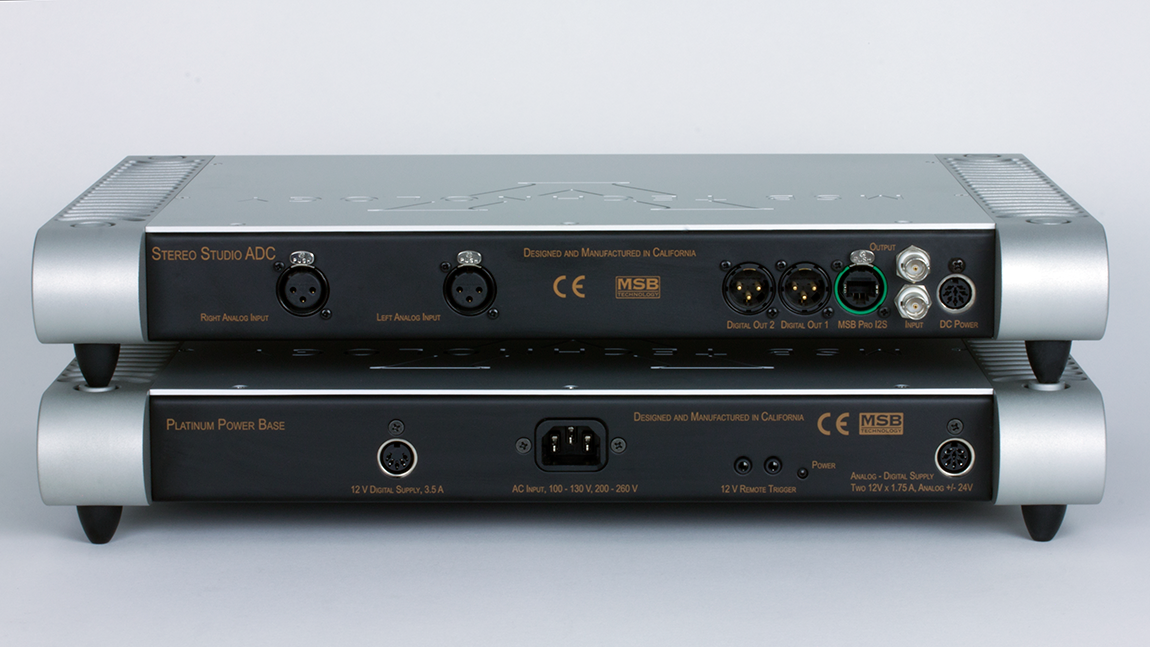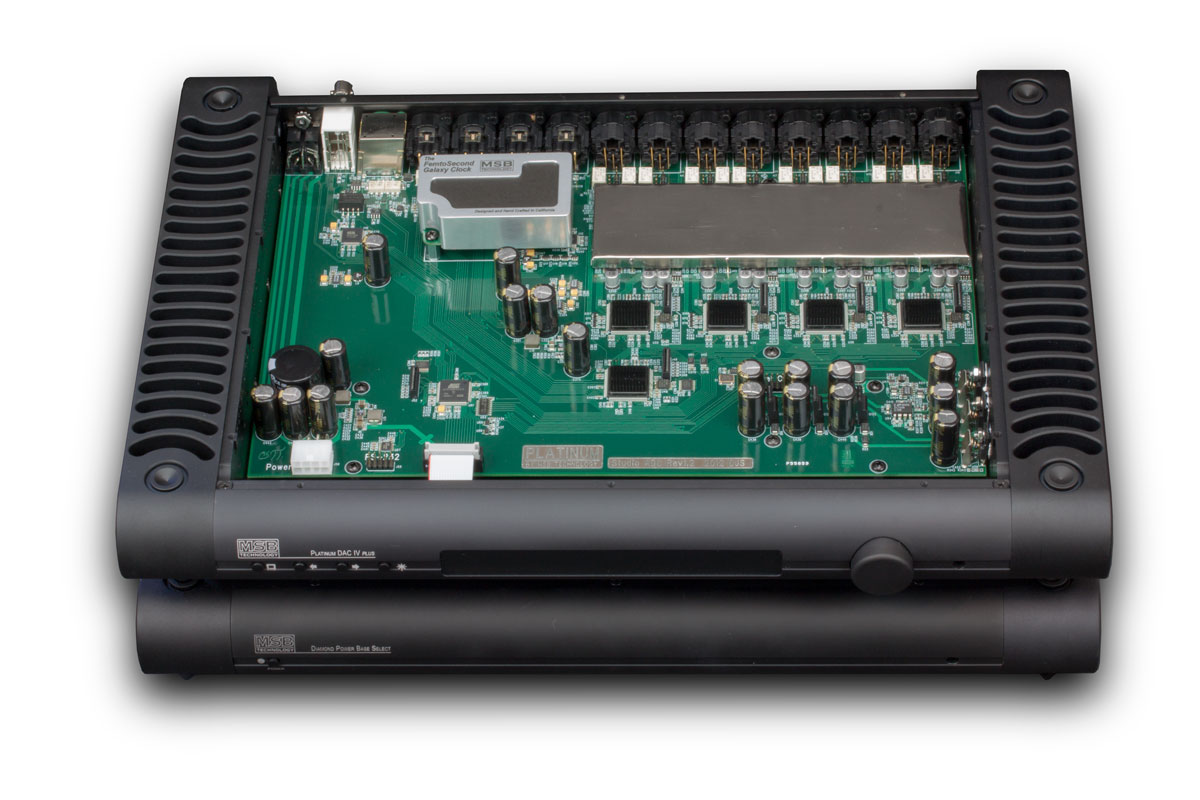The ADC V - Support

Audio clock options
When pursuing the best quality in recording, the best clocks are needed to reduce jitter. The ADC V works with MSB’s entire range of femto clocks.
Available Clocks:
Femto 140
Femto 77
Femto 33
The ADC V - Features

A Long History
The Platinum ADC plus has grown out of over 20 years of DAC development. Analog-to-Digital-Converters, ADCs, like DACs are generally designed with a chip from someone like Analog Devices or Burr Brown and simply put in a box. As a result, all which use the same chip sound about the same. Years ago we at MSB broke away from this mode by designing our own entirely discrete DAC. In years past we have produced several ADCs, but by the conventional method. Finally, we have now addressed the analog-to-digital conversion problem with the same care we have invested in the digital-to-analog conversion problem.
During the development of our new Diamond DAC technology we were faced with the challenge of making a DAC more accurate than any audio DAC ever produced. The first quandary we faced was finding an accurate and automated way to measure the output. Our first task was to acquire the most accurate ADC we could. Well, as you can guess, nothing we could find came close to the precision we needed. So once again, necessity drove us to develop the best ADC we could imagine. As the design was not restricted by a product requirement, we simply did the best we could.
About the ADC plus
Once the core analog conversion engine was designed, we added all the features to make this ADC a truly high-performance and flexible product. Clock accuracy and stability is just as important in an ADC as it is in a DAC, so of coarse we have provided our clock header so you have access to our most accurate clocks. The ADC pluscomes stock with our Femto140 clock. The ADC can also accept the world’s most stable clock, the MSB Femtosecond Galaxy Clock, a plugin option that provides a clock with an amazing 77 femtoseconds of jitter (.077 picoseconds). We also made provision to output that stable clock as a source clock for optimum studio use. We also accept an input clock for those applications where a studio clock of high accuracy already exists, allowing the ADC to sync with video, although this is not the optimum configuration.
About the Digital Filter
Just as in DACs, digital filtering is also required in the conversion of analog to digital, and it turns out that its role in audio quality is just as important. Just as in our DACs, MSB has designed our own DSP based filter that far exceeds the performance available with integrated single chip solutions. This product has 8 delta sigma converters and 5 of the fastest DSPs Analog Devices makes!
ADC plus Performance
While others are worried about adding more features and computer interfaces, MSB is investing in audio performance. Check out our jitter measurements. The proof is in the sound of the recordings. Although MSB ADCs have been used “under the table” HDtracks recently released the first commercial title which was mastered on this ADC and MSB was given credit in the album promotion. Cat Stevens Tea for the Tillerman was remasterd directly from tape to 24 bit, 192kHz by Ted Jensen of Sterling Sound with remarkable success. David Chesky confirmed the quality of the ADC and has been using it on many projects.
Features and Controls
This ADC is fully configurable with word lengths and bit depth adjustable up to with 32-bit output resolution, and sample rates up to 384 kHz. There are several grounding options that can be selected including complete isolation. Each input has a +/- 10 db trim adjustment and a full digital mixing of all 8 channels is possible, all with simple setup controls.

8Ch. ADC plus Specs:
2 Balanced 6.144 MHz 6bit Delta-Sigma Modulators Per Channel
One Balanced Amplifier Per Channel
Input Impedance:
100K Balanced
50K Single-Ended
THD+N: (measures higher near 0 db because of zero feedback buffer)
1Khz @ 0 db: 0.005%
1Khz @ -3 db: 0.003%
1Khz @ -14 db: 0.0004%
1Khz @ -30 db: 0.0007%
Dynamic Range:
48Khz: 148 dbA
96Khz: 145 dbA
192Khz: 143 dbA
384Khz: 140 dbA
Stereo ADC plus Specs:
8 Balanced 6.144Mhz 6bit Delta-Sigma Modulators Per Channel
4 Balanced Amplifier Per Channel
Input Impedance:
25K Balanced
12.5K Single-Ended
THD+N: (measures higher near 0 db because of zero feedback buffer)
1Khz @ 0db: 0.004%
1Khz @ -3db: 0.002%
1Khz @ -14db: 0.0002%
1Khz @ -30db: 0.0005%
Dynamic Range:
48Khz: 153 dbA
96Khz: 150 dbA
192Khz: 1148 dbA
384Khz: 145 dbA
ADC plus Specs:
Digital Outputs:
2 or 4 AES/EBU Balanced
Coaxial (Stereo Model only)
MSB2 Outputs
(new MSB Network with imbedded clocks)
Clock Jitter: 5 ppm TCXOs
Clock In
Clock Out
Trim Control:
+/- 10dB
Output Sampling Frequency:
44.1Khz, 48Khz, 88.2Khz, 96Khz, 176.4Khz, 192Khz, 352.8Khz, 384Khz
Output Resolution:
up to 32 bits
Fully differential zero feedback discrete input buffers:
Low Gain Setting 0db: 26 Vpp 9.28 Vrms
High Gain Setting 0db: 13Vpp 4.64Vrms
Settable Gain: up to +60db (with plug-in)
Common Mode Input Range: 28V
Channel Separation @1Khz: >160db
Channel Separation @24Khz: >140db
Gain Flatness as measured, (Includes Amplifier and Digital Filter):
2 stage FIR
-0.01db @44.1Khz: 21.54Khz
-3.0db @44.1Khz: 21.74Khz
-0.01db @48Khz: 23.47Khz
-3.0db @48Khz: 23.64Khz
Single Stage FIR
-0.01db @88.2Khz: 26.6Khz
-3.0db @88.2Khz: 32.1Khz
-0.01db @96Khz: 29.0Khz
-3.0db @96Khz: 35.0Khz
-0.01db @176.4Khz: 49.6Khz
-3.0db @176.4Khz: 62.0Khz
-0.01db @192Khz: 54.0Khz
-3.0db @192Khz: 67.5Khz
-0.01db @352.8Khz: 50.0Khz
-3.0db @352.8Khz: 71.2Khz
-0.01db @384Khz: 54.0Khz
-3.0db @384Khz: 77.53Khz
ADC Latency:
@44.1Khz: 5.06ms (2 stage FIR)
@48Khz: 4.65ms (2 stage FIR)
@88.2Khz: 0.72ms (Single Stage FIR)
@96Khz: 0.66ms
@176.4Khz: 0.39ms
@192Khz: 0.36ms
@176.4Khz: 0.23ms
@192Khz: 0.21ms
Control Features:
Remote
Frequency
Bit Depth
Trim (8x)
Mixing
Grounding

Technology Details
The architecture of the ADC plus is radically different from the rest of the ADCs on the market, so thats probably why it sounds so different. One other difference is that it has a proprietary zero feedback amplifier which is totally unique. Its characteristics are:
- Very flat frequency response
- a flat distortion vs. frequency response
- very low noise with noise rising slightly at low frequencies
- Very good common mode rejection with a very large common mode range (similar to a transformer as long as its between its power supply rails)
- a high order rolloff beyond 400 kHz so that by the time it reaches Nyquist at 3 MHz any interference that would alias down into the audio band is attenuated drastically
- the rolloff is not a filter its just a parameter of the amplifier so there is actually no additional analog filtering necessary like a standard ADC would require
- One drawback is that it has a rising distortion with signal level so that at 0db it does not have amazing distortion specifications but for lower levels it improves to incredibly low levels of distortion. This Distortion vs. Signal Amplitude tradeoff is not audible at all as long as the distortion is still reasonably low and completely harmonic in nature (without a harmonic content).
The ADC also does not use any computation outside our control as we take the raw output of the Delta Sigma modulators (6 bit at 6 MHz times two modulators per channel) and process it all with 80 bit fixed point precision in the SHARC DSPs using super high resolution digital filters. So common downsampling algorithms in commodity chips are not used.

